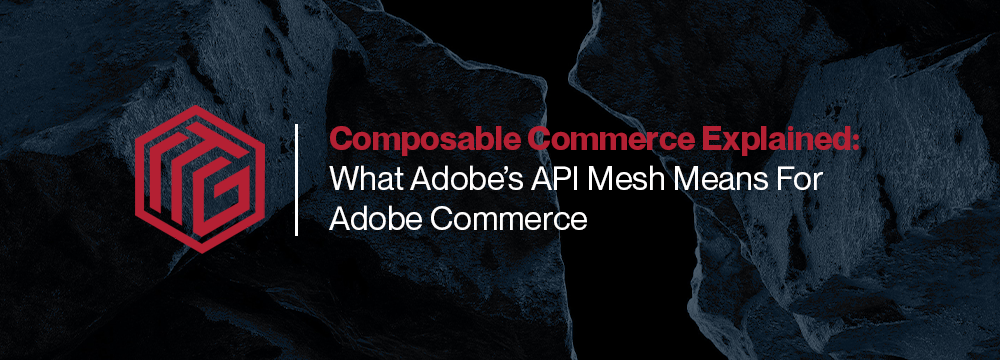In the ever-evolving world of digital commerce, staying ahead of the curve is essential. Composable Commerce represents a natural progression for customers of Adobe Commerce and Magento, providing a means to advance your existing platform without incurring substantial risks. In this post, we’ll provide a high-level overview of Composable Commerce, its significance, its evolution, and how ITG Commerce leverages Adobe’s API Mesh to help clients on the journey – reducing risk and eliminating the need for replatforming to move forward.
What Exactly is Composable Commerce
Think of your e-commerce platform as a house that could use an update and renovation and in order to get what you want, you need to move some walls and plumbing. Modern construction, plumbing, and electrical has evolved such that there are standardized sizes, regulations, and specs which can come together more efficiently when building something new or remodeling. And just like adding a new bathroom or an extra room, Composable Commerce allows you to update and expand your existing setup while working with more standardized components and standards – yet tailored to your business needs and in order to deliver the customer experience you need to succeed.
With a Composable Commerce approach, businesses can embrace a modular approach, selecting the best components for their needs. From shopping carts to payment gateways and content management systems, these pieces seamlessly integrate to build a flexible and agile commerce ecosystem.
Why Composable Commerce Matters
1. Flexibility: Composable Commerce empowers businesses to swiftly adapt to shifting market trends and customer preferences. You’re not confined into a rigid system; you can swap out components as needed to remain competitive.
2. Personalization: In today’s world, personalized experiences are a must. Customers expect personalization at scale, and that’s where ITG steps in. As your one-stop-shop for custom development, our expert team excels in frontend, backend, and server-side technologies. With Composable Commerce, we make it easier to gather data from various sources and use it for tailored shopping experiences that keep your customers coming back.
3. Scalability: As your business grows, the complexity of your digital commerce needs also increases. Composable solutions scale with you, guaranteeing you can manage growing traffic, transactions, and diverse customer demands.
4. Innovation: By harnessing the latest and best-of-breed solutions for each component, you can remain at the forefront of commerce innovation, securing a competitive edge.
The Evolution of Composable Commerce Over the Last 3 Years
The concept of Composable Commerce has undergone significant transformation in recent years, influenced by technological progress and evolving customer expectations.
Era of Monoliths: In the early days, commerce platforms were monolithic, single-tenant solutions – offering limited customization out-of-the box. Customization was possible, but expensive and bespoke. Heavy customization led to much higher cost of ownership to support both upgrades and innovation, and were slow and problematic to innovate upon.
The Rise of SaaS: Software-as-a-Service (SaaS) brought the monolith to the cloud, and made it easier for more brands to take advantage of e-commerce platforms while running them in the cloud, with on-demand infrastructure to support scaling and performance. As a trade-off, many of the early SaaS e-commerce platforms naturally had to constrain the degree of customization possible within the core of the platform and add in connectors and integrations to support common best-of-breed compliments and add-ons to the core platform. These solutions often created a new set of constraints, while also democratizing use of these powerful platforms and reducing the cost to run them.
Maturation of APIs and the rise of Microservices: APIs became a common and popular way to connect the various systems used to drive the digital business and customer experience forward in the early to mid-2000’s. At the start these APIs were often used to connect older systems together, and add in best-of-breed compliments. While providing significant benefits – such as reducing the need to keep systems perfectly in sync as they evolved – this way of connecting systems together was often still done ‘point-to-point’ and still required a lot of work to connect systems together. Meanwhile, the platforms themselves started to use APIs within their solutions, with ‘fine-grained APIs’ known as microservices. This brought additional benefits to how these solutions could be built and run – offering customers the ability to use smaller and smaller parts of these solutions without using the whole solution and to innovate and compliment within them. This is what laid the foundation for composability.
Composable Technology Strategy: Today, specialized tools and strategies have emerged to accommodate both legacy and best-of-breed solutions. The goal is to simplify the process of using best-of-breed solutions to complement your core applications such as your commerce platform and make integrating these solutions easier and easier. While offering a lot of promise, this hasn’t been an instant success as it can add complexity. This is where the support from knowledgeable partners is key.
While many composable commerce solutions are still evolving, there is growing maturity as the investment in integration frameworks and data-models have increased. Several major commerce platform players – such as Adobe, Salesforce, SAP, Shopify and BigCommerce – have adjusted their product roadmaps to align more with the composable direction, for good reason – their customers need it. Many are transforming their well-established commerce functionality into composable features connected via APIs and microservices – giving customers greater freedom to build their own technology stack with both customization and best-of-breed solutions – such as search, PIM, OMS, and many other areas. This is an exciting time in our industry, and the “race to innovation” is captivating to watch.
Unlocking the Power of Adobe’s API Mesh for Composable Commerce
Adobe’s API Mesh serves as a conductor for your digital commerce orchestra, offering a unified, scalable, and secure solution for connecting and orchestrating not only Adobe Commerce APIs but all the APIs that are part of the orchestrion project which greatly simplifies the implementation of composable commerce while minimizing risk. Here’s how it can benefit your business:
1. Streamlined Integration: Adobe’s API Mesh simplifies the integration of third-party services and components, ensuring that they work seamlessly together. Developers are not customizing core application code so there is a low cost of ownership and higher developer productivity.
2. Enhanced Security: Robust security features protect your commerce ecosystem from potential threats and vulnerabilities.
3. Real-time Insights: Gain valuable performance insights enabling data-driven decisions. You can maintain a distributed and diverse tech stack while harnessing the power of analytics, AI, and more, whether they are Adobe-branded or not.
4. Future-Proofing: Adobe’s API Mesh adapts to the evolving digital commerce landscape, ensuring the continued relevance of your Composable Commerce strategy. Notably, it allows you to incorporate best-of-breed point solutions whether they are Adobe products or not.
“Adobe’s API-Mesh is Adobe’s approach to simplifying and enabling a composable-friendly approach to drive innovation and evolution for Adobe customers. This is especially valuable for brands and businesses needing to evolve and transform their digital commerce experience. While powerful, API-Mesh is both new and can be complex. Partners like ITG play a crucial role in assisting Adobe Commerce customers in navigating how best to use and implement these innovations and tailor them to their specific needs. ITG’s extensive experience with both Adobe Commerce and building composable solutions positions them as an excellent choice for businesses needing to explore composability and how to move their Adobe Commerce solutions forward.”
Bill Friend, former Adobe Commerce General Manager
In conclusion, Composable Commerce is a welcome, natural evolution of the modern commerce platform – offering the promise of flexibility, adaptability, scalability, and innovation. Some would argue that moving this direction requires replatforming to a new commerce solution, but that is not the case for Adobe Commerce’s customers – and let’s be honest, for many, starting from scratch isn’t practical or budget-friendly, regardless of how enticing it may sound.
Adobe’s API Mesh has emerged as an invaluable framework, empowering businesses to embark on their Composable Commerce journey with confidence and ease. At ITG, we have the experience to support clients leveraging API Mesh to its full potential, helping them to make the right choices for their unique needs.
If you enjoyed this post, please join us to talk more about Composable Commerce and learn how to extend the life of your Magento investments. Our live webinar, “Composable Commerce and Cocktails with Magento,” will take place on Thursday, November 2nd at 4:00 pm EST. In this exclusive event, industry veterans Brian Walker and Bill Friend will guide you through a lesson in mixology and discuss Adobe’s API Mesh and its role in the composable future. Don’t miss out – register today!

E-commerce Growth Advisor and Guest Writer, Brandon brings over a decade of invaluable experience to the industry. Formerly the Vice President of Sales & Commercial Growth at Corra, Brandon’s expertise provides a unique and insightful perspective in navigating the dynamic landscape of e-commerce.

